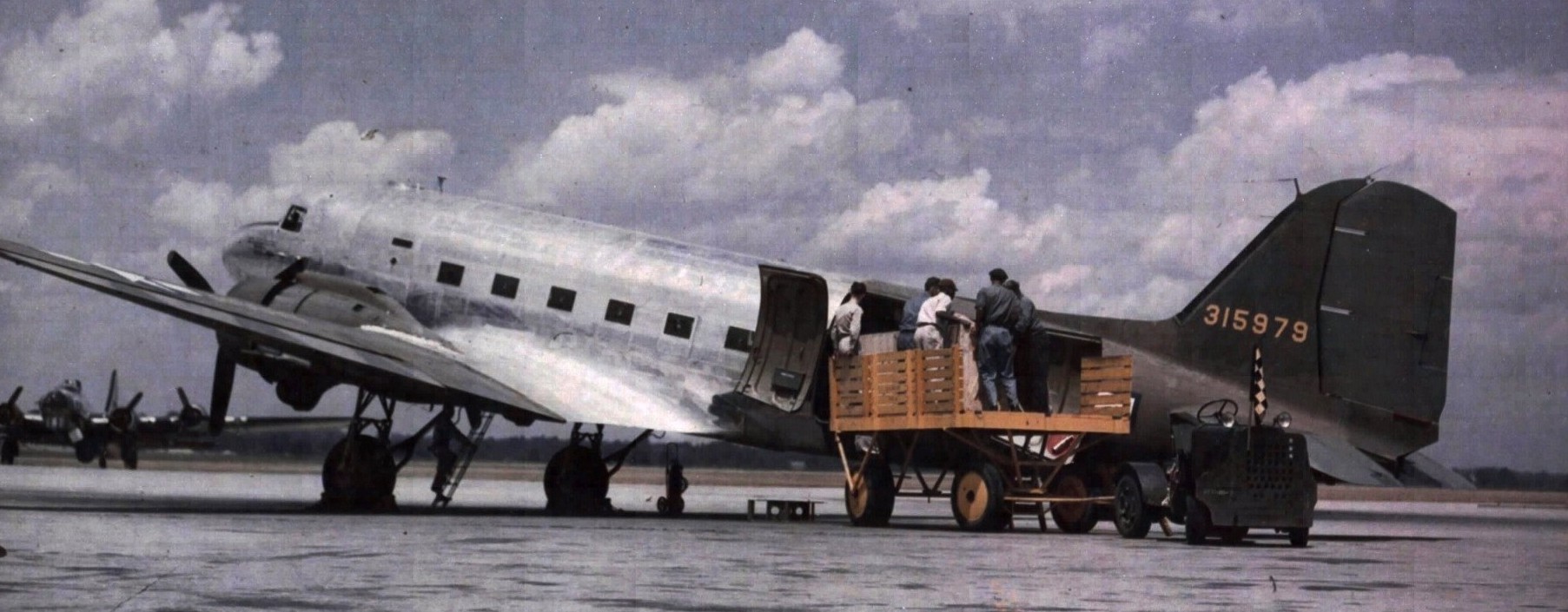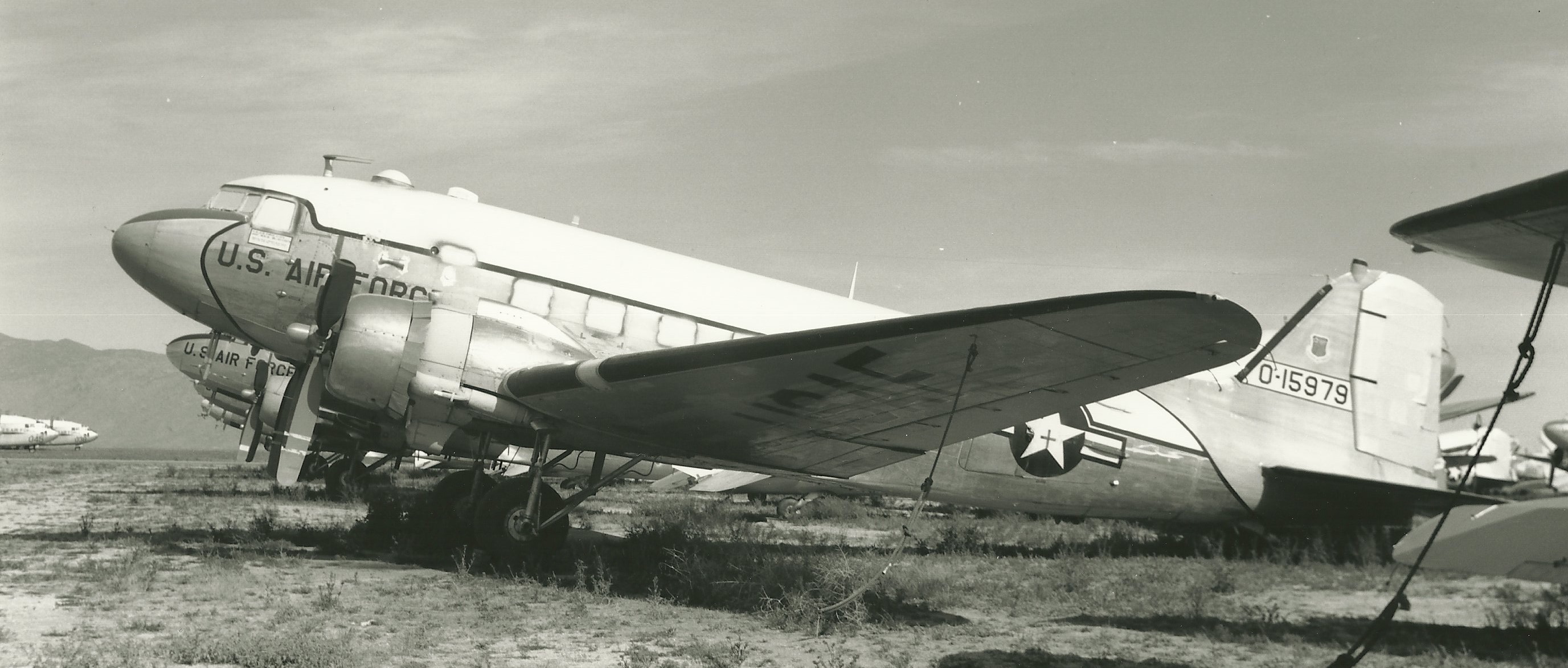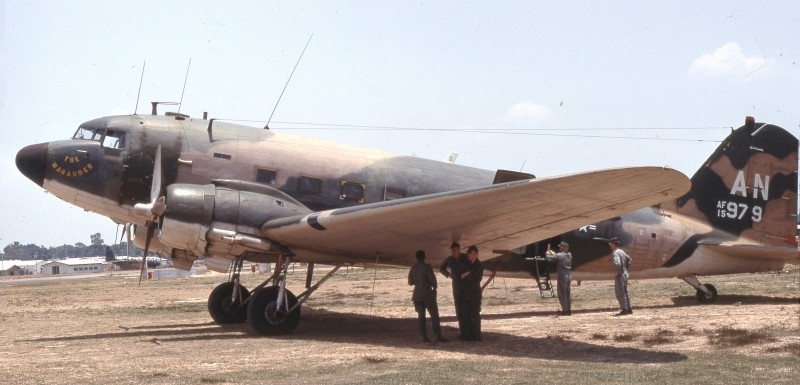A Late Addition: After this article was originally written, we decided to elaborate on EC-47 serial numbers and model designations. The photos below show the evolution of the USAF "tail number" system from WWII to the Vietnam war years, as illustrated by one of our own Electric Goons. Rather than duplicate these illustrations elsewhere, we decided to amplify this article to include an explanation of USAAF/USAF serial numbers and their relationship to aircraft tail numbers over the years.
One EC-47's Story
C-47A-90-DL, AAF serial number 43-13979, rolled off Douglas Aircraft’s Long Beach, California, assembly line around the end of May, 1944. On 2 June, the aircraft was at Morrison Field (Palm Beach, Florida). War’s end found 979 at Brookley Field, near Mobile, Alabama. After bouncing around Stateside for a few months, in early 1948 she found a home in Alaska, at one time or another being assigned to both Elmendorf (Anchorage) and Ladd (Fairbanks) AFB. In 1951, the ol' Goon was spiffed up with an airliner-like interior and redesignated as a VC-47, the "V" indicating Staff Transport (or VIP). After fifteen years of tooling around The Last Frontier, In 1963 she was sent to the "boneyard" at Davis-Monthan AFB, just outside Tucson, Arizona.
In September, 1966, the mothball covering came off and 979 left the Arizona desert for Air International in Miami, the outfit contracted to begin the process of conversion into an EC-47. Production snags at Sanders Associates delayed installation of the AN/ALR-34 ARDF system until February, 1967. One of the last PHYLLIS ANN birds to make the transpacific crossing, 979 finally arrived at Pleiku on 16 April 1967. It was here that "The Marauder" name was applied, although exactly when or by whom we don't know. By early 1970, however, all EC-47 nose art had been removed.
Like most other N and P models, 979 was shuffled from squadron to squadron after completion of regularly scheduled Inspect and Repair as Necessary (IRAN) work in Taiwan. Had the AAA round she took on 24 April 1968 burst a few feet in another direction, 979 might well have been added to the shoot-down list of EC-47s. As it turned out, the old bird soldiered on to the bitter end, being one of 33 EC-47s turned over to the VNAF in 1973. Several EC-47s escaped to U Tapao when Saigon fell on 30 April 1975. It is not known if 43-15979 was among them.
Tail Numbers Illustrated: 43-15979 Over the Years
WWII to the late 'fifties. In the case of 43-15979, the "43" in the serial number indicated the last two digits of the fiscal year in which the aircraft was ordered; 43-15979 being the 15,979th aircraft ordered by the USAAF in fiscal year 1943. From 1941 until around 1958, a slightly abbreviated serial number was painted on the tails of USAAF/USAF aircraft. The first digit of the already shortened fiscal year was omitted, and zeros were added if the order sequence number was less than four digits. (e.g., S/N 45-925 would be marked 50925.) Thus 43-15979 carried tail number 315979, as shown below. This view is of the bird in her early days, probably shortly after the end of WWII. Note that the wartime olive drab camouflage paint has been stripped from the forward fuselage. (USAAF photo via Fold3.com)

Into the 'sixties. By the time 43-15979 arrived in the Arizona desert in 1963, the USAF had changed its tail number presentation. The number was generally shortened to five digits, which sufficed in the immediate post-war years when the USAF rarely came anywhere close to procuring more than 9,999 aircraft in a single fiscal year. But many aircraft were now remaining in service for more than 10 years, in which case and an “O” (for “obsolete”) was placed as a prefix to the tail number. Thus an aircraft spotted in 1964 carrying O-31234 on the tail could reasonably be assumed to be 53-1234. Not so for the Gooney Bird, several hundred of which remained in the inventory well into the 1960s. Some of these, the future EC-47 42-108980 for example, would’ve formerly carried 7-digit tail numbers. Which digits to chop was never adequately specified; the fiscal year digit was usually the first to go. The photo below shows 43-15979 cocooned at D-M, still sporting the VIP paint scheme (probably "day-glo" nose and tail, white top, blue or black "cheat lines") but now with tail number O-15979. (Norm Taylor photo)

Back to warpaint. For the aircraft identification geek, worse was yet to come. When the USAF began camouflaging its tactical aircraft in 1965-66 then added squadron code letters a year or so later, the tail number application became even more confusing. (Click here for a detailed explanation of camouflage and markings applied to the EC-47.) The following photos show 43-15979 at two different times during her time in SEA. The one immediately below was taken while 979 was assigned to the 362nd TEWS. Contrary to T.O. requirements, the "AF" and the complete tail number, now just 15979, are all in white and the AN squadron code crosses over on to the rudder. (Norm Taylor photo)

More minor changes. Sometime in 1970-71, Norm Taylor caught 979 with a fresh paint job and now assigned to the 360th TEWS (AJ) at Tan Son Nhut. The radome is now the same color as the adjacent camouflaged areas and the propeller warning stripe has been applied. "The Maruader" nose art is long gone. As the U.S. withdrew in 1973, the squadron codes again disappeared. (The 361st was the only ARDF TEWS left in SEA.) In this shot, the squadron code letters and tail number, including the leading "O", are correctly applied. But with only this photo to go by, it's virtually impossible to determine the full serial number of the aircraft.

Joe Martin notes: "My flight records show I flew 12 missions on 979 during 1970-1971, all but one out of TSN. The other was from NKP."
(Return to the main "Marauder" article)
(Click here to go to EC-47 Model Designations)
